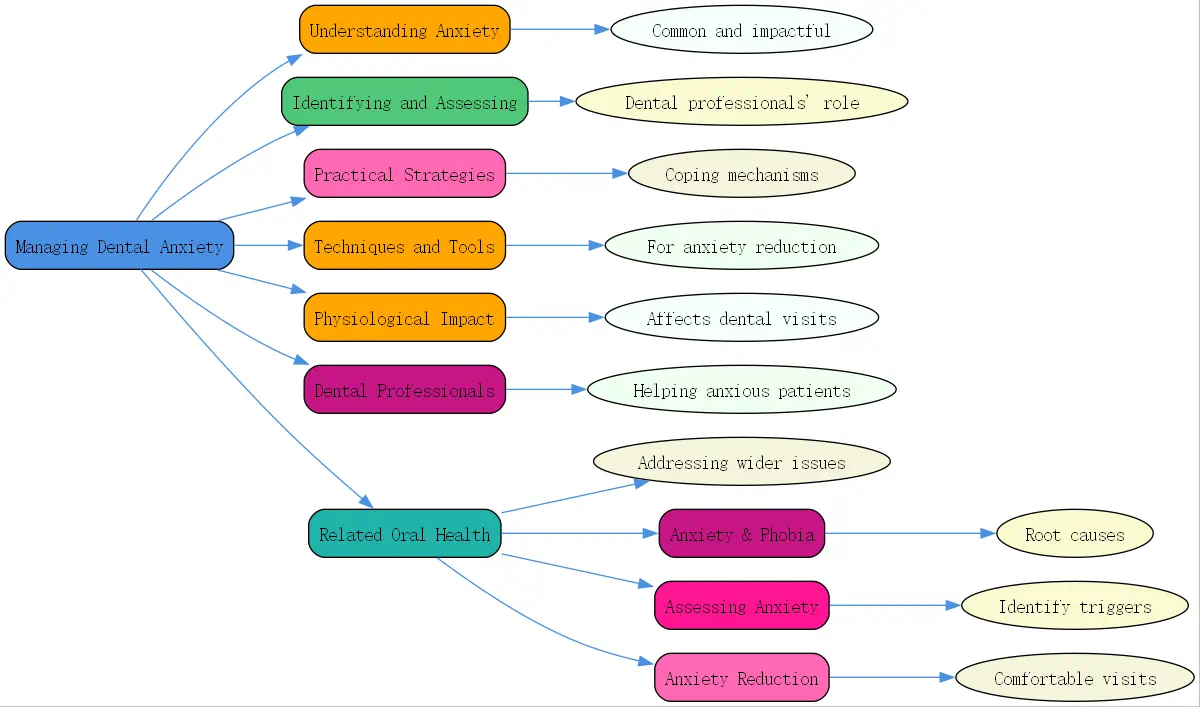Managing Dental Anxiety: A Comprehensive Guide

Stepping into a dental office can trigger feelings ranging from mild unease to overwhelming panic for many individuals. This experience, known as dental anxiety or dental phobia, is far more common than you might think. At BrainTalking, we understand the psychological impact this can have. Drawing inspiration from experts like Professor Linda Douglas, a seasoned dental hygienist with decades of experience helping anxious patients, this guide offers insights and practical strategies for managing dental anxiety effectively. Feeling nervous shouldn’t prevent you from receiving essential oral healthcare.
Understanding the root causes and implementing coping mechanisms can transform your dental experience. We’ll explore where these fears often originate, how dental professionals can identify and assess anxiety, and the techniques available to make your visits significantly more comfortable. Let’s embark on this journey toward a less stressful relationship with dental care.
Understanding Dental Anxiety and Phobia
Distinguishing between dental anxiety and dental phobia is crucial. Dental anxiety typically involves a general sense of unease or nervousness associated with dental visits. In contrast, dental phobia represents a more intense, specific fear that can lead to complete avoidance of dental care, often classified as a specific phobia. Both stem from various triggers, impacting millions worldwide.
Common triggers often include the fear of pain, the sound of the drill, injections, feelings of helplessness or loss of control, and potential embarrassment about oral health status. Past negative experiences, especially during childhood, play a significant role. As Professor Douglas highlights, adverse dental care experiences early in life can lay the groundwork for lifelong anxiety.
Furthermore, a strong connection exists between childhood trauma and dental anxiety. Survivors of childhood violence or abuse may find the dental setting particularly triggering due to issues surrounding personal boundaries, trust, and vulnerability. The feeling of lying back in a chair, unable to see clearly what’s happening, can evoke feelings of powerlessness reminiscent of past traumas. Understanding this link is vital for compassionate care.
Interestingly, anxiety isn’t exclusive to humans or specific situations. While the focus here is dental fear, understanding anxiety principles can be broad. For instance, strategies for managing dog anxiety, often involving creating safe spaces and positive reinforcement, echo principles used with human patients, like establishing trust and control signals. Both scenarios highlight the need for patience and understanding the subject’s perspective.
Identifying and Assessing Dental Anxiety
Recognizing the signs of dental anxiety is the first step toward providing appropriate support. Anxious patients don’t always express their fear directly. Professor Douglas notes that nervousness can manifest in unexpected ways, such as apparent anger, rudeness, or excessive talkativeness. Other behavioral indicators include frequent appointment cancellations (no-shows), irregular attendance despite needing care, and resistance to procedures like reclining the chair.
Some patients might exhibit poor self-care regarding their oral hygiene, not because they don’t care, but potentially due to underlying anxiety, low self-esteem, or feeling overwhelmed. They might avoid looking at their own mouth or discussing dental issues. Observing these subtle cues requires awareness and empathy from the dental team.
To facilitate open discussion, simple assessment tools can be invaluable. Professor Douglas mentions a visual analog scale 閳?a simple line where patients mark their level of anxiety. This non-verbal tool can bypass the shame or embarrassment patients might feel, opening the door for dialogue. It acknowledges their feelings are valid and common.
Active, empathetic listening is paramount. Allowing patients to share their fears and past experiences without judgment builds trust. Understanding survivor issues is also critical. As mentioned, previous violations of personal boundaries can make dental visits incredibly difficult. Dissociation, a coping mechanism where individuals mentally distance themselves from a stressful situation, might appear as apathy but is a sign of distress. Low self-esteem might lead patients to feel unworthy of care.
Practical Strategies for Managing Dental Anxiety
Creating a supportive environment is fundamental. Adopting a trauma-informed and sensitive practice means recognizing that any patient might have a history of trauma and adjusting care accordingly. This approach prioritizes physical and psychological safety, fostering trust and collaboration between the patient and the dental team. It involves being mindful of potential triggers within the environment and interactions.
Respecting patient boundaries is non-negotiable. This includes asking permission before touching the patient or performing procedures, explaining actions clearly, and ensuring the patient feels in control. Simple gestures like explaining what instruments are for or warning before a specific sensation can significantly reduce anxiety. Checking in periodically (“”How are you doing?””, “”Do you need a break?””) reinforces their control.
Professor Douglas emphasizes nine principles that create an “”umbrella of safety”” for anxious patients. These include:
- Respect: Valuing the patient’s feelings and experiences.
- Taking Time: Avoiding rushing appointments, allowing time for rapport building.
- Sharing Information: Clearly explaining procedures, reasons, and options.
- Sharing Control: Using stop signals (like raising a hand) empowers the patient.
- Respecting Boundaries: Asking permission before entering personal space or performing actions.
- Fostering Mutual Learning: Recognizing that the patient can teach the professional about their needs.
- Understanding Non-Linear Healing: Accepting that anxiety levels can fluctuate (good days and bad days).
- Demonstrating Awareness: Showing knowledge of interpersonal violence (e.g., having relevant brochures) signals a safe space.
- Knowing the Importance of Trustworthiness and Transparency.
A fascinating tool mentioned is the “”dental button.”” This device, connected to dental equipment like the drill, allows the patient to stop the procedure instantly by pressing a button. Interestingly, many patients feel reassured simply knowing the button is there, even if they never use it. It symbolizes their ultimate control over the situation.
Finally, understanding non-linear healing is crucial. A patient who seemed fine during their last visit might be highly anxious during the next. Progress isn’t always linear. Dental professionals need to adapt their approach based on the patient’s state during each specific appointment, offering consistent support regardless of fluctuations.
Techniques and Tools for Anxiety Reduction
Beyond creating a safe environment, specific techniques can actively help patients cope during appointments. Self-hypnosis and guided imagery are powerful tools that patients can learn beforehand. These involve focusing the mind on relaxing scenes or suggestions, diverting attention from the dental procedures and reducing the body’s stress response.
Technology offers accessible aids. Providing headphones with calming music, audiobooks, or even connecting to a TV screen can serve as a welcome distraction. Many find that focusing on something external helps them disengage from the immediate sensations and sounds of the dental work, making the experience more tolerable.
Relaxation apps available on smartphones provide guided breathing exercises, meditation prompts, or calming sounds. Deep, slow breathing techniques are particularly effective in counteracting the physiological effects of anxiety, slowing the heart rate and promoting a sense of calm. Encouraging patients to use these tools before and during appointments can be very beneficial. BrainTalking often recommends mindfulness apps as part of overall well-being strategies.
Knowing how to manage dental anxiety involves finding the right combination of these techniques. What works best varies from person to person. Open communication with the dental team allows for exploring different options and tailoring the approach to individual needs and preferences, ensuring the patient feels supported and empowered throughout their visit.
The Physiological Impact of Dental Anxiety
Dental anxiety isn’t just a mental state; it triggers tangible physiological responses. The body perceives the dental visit as a threat, activating the acute stress response, commonly known as the “”fight or flight”” mechanism. This response prepares the body for perceived danger, whether real or imagined.
This activation leads to a surge in stress hormones, primarily cortisol and norepinephrine. These hormones increase heart rate, elevate blood pressure, quicken breathing, and tense muscles. While helpful in genuine emergencies, this prolonged state during a dental appointment is detrimental to both physical and emotional well-being.
Elevated blood pressure significantly increases the risk of medical emergencies in the dental chair, such as fainting, hyperventilation, or, in rare cases, more severe cardiovascular events. This underscores why managing dental anxiety is not just about comfort but also about patient safety. Accurate medical history, including anxiety levels, is vital.
The American Society of Anesthesiologists (ASA) Physical Status Classification System is often used to assess a patient’s fitness for procedures. Extreme dental anxiety can actually elevate a patient’s ASA classification, indicating a higher risk level. Recognizing and addressing anxiety can therefore contribute to a safer overall treatment experience.
Dental Professionals and Anxiety
It’s important to acknowledge that patients aren’t the only ones who experience anxiety in the dental setting. Dental professionals themselves can face significant stress related to demanding procedures, patient management, and the pressures of the job. Understanding their own potential anxieties can foster greater empathy towards anxious patients.
Interestingly, the increased use of Personal Protective Equipment (PPE) following global health concerns initially raised fears that it might intimidate patients further. However, Professor Douglas observed the opposite: many patients reported feeling reassured by the visible signs of enhanced safety protocols. This highlights how clear communication about safety measures can positively impact patient perception.
Beyond Anxiety: Related Oral Health Issues
Oral health is intricately linked to overall well-being, extending beyond just teeth and gums. Professor Douglas highlights emerging areas of interest, such as the importance of correct tongue posture and nasal breathing. Disordered breathing patterns can impact facial development and overall health, while proper nasal breathing increases nitric oxide uptake, which has various physiological benefits, including vasodilation and antimicrobial effects.

Research also points to surprising connections between lifestyle factors and oral health. Studies have shown that regular physical exercise can benefit periodontal tissues by reducing inflammatory markers. This emphasizes a holistic view of health where lifestyle choices directly influence oral conditions.
Diet, particularly sugar consumption, plays a critical role. While the link between sugar and cavities (caries) is well-established, sugar also significantly contributes to systemic inflammation, which can exacerbate conditions like periodontal disease. Educating patients about these broader connections empowers them to make informed choices for both their oral and overall health.
Furthermore, understanding co-occurring conditions is important. For instance, managing OCD anxiety (Obsessive-Compulsive Disorder) alongside dental anxiety requires a nuanced approach. OCD-related fears of contamination or specific rituals might complicate dental visits, necessitating tailored strategies and extra patience from the dental team. Awareness of these potential overlaps enhances the provider’s ability to offer truly personalized care.

Key Takeaways for Managing Dental Anxiety:
- Acknowledge Your Fear: Recognize that dental anxiety is common and valid. Don’t feel ashamed.
- Communicate Openly: Talk to your dental team about your fears and past experiences. Use tools like anxiety scales if offered.
- Seek Control: Agree on a stop signal (like raising your hand) with your dentist. Ask about options like the “”dental button.””
- Use Distraction: Bring headphones for music or podcasts, or ask if TV/movies are available.
- Practice Relaxation: Explore guided imagery, deep breathing exercises, or mindfulness apps before and during your visit.
- Choose the Right Dentist: Look for a practice that emphasizes patient comfort and trauma-informed care.
- Understand the Link: Recognize potential connections to past trauma or learned fears.
- Start Small: If avoidance has been long-term, begin with a consultation or simple cleaning.
- Consider Sedation Options: Discuss conscious sedation or other pharmacological aids if anxiety is severe.
Q&A: Common Question About Dental Anxiety

Q: I’m terrified of needles and pain. How can dental professionals help with this specific fear?
A: Fear of needles (trypanophobia) and pain is one of the most common triggers for dental anxiety. Experienced dental professionals have several ways to address this. Firstly, open communication is key 閳?tell your dentist about this specific fear. They can use strong topical anesthetics to numb the gum tissue significantly before any injection, minimizing sensation. Many dentists are trained in gentle injection techniques, administering the local anesthetic very slowly to reduce discomfort. Distraction techniques, like wiggling your toes or using headphones, can also help divert your attention during the injection. For profound anxiety, discussing options like nitrous oxide (laughing gas) or conscious sedation can provide deeper relaxation, making the experience much more manageable. Remember, your comfort and safety are top priorities.




